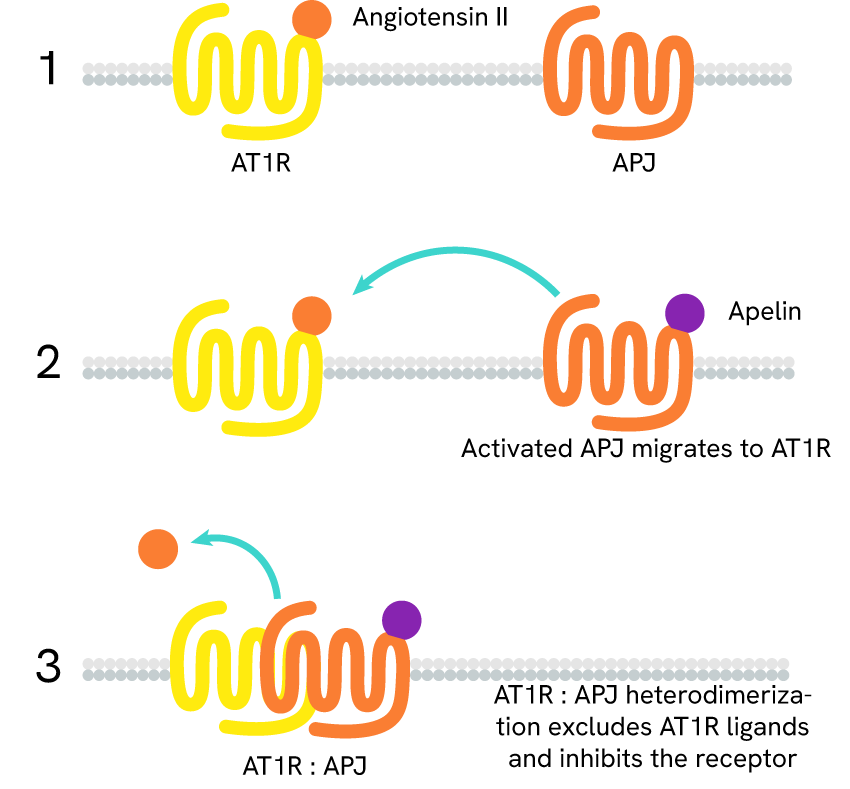
GPCRs are key players in cell signaling and a cornerstone of research in cardiovascular disorders and diseases (CVDs). In the last decade, second messengers have risen to the occasion and provided relevant results for monitoring GPCR activity as specialized assay were developed to address the specific signaling of G proteins spectrum. Here we report published studies in which cAMP and IP-One HTRF second messenger assays were successfully used to monitor Gi/s and Gq activity and allowed for a better understanding or addressing of cardiovascular-specific GPCRs.

IP-1 and cAMP in GPCR signaling: IP-1 increase characterizes Gq protein activation while cAMP levels are respectively dampened or increased by Gi and Gs proteins via modulation of adenylate cyclase activity.
APJ-related inhibition of the angiotensin receptor
In 2012, Siddiquee et al investigated the angiotensin II type 1 receptor (AT1R), one of the most studied GPCRs found in cardiovascular tissues and who’s intracellular signaling is transduced through Gi/o proteins. It had been observed previously that this receptor exhibits interacting behaviors toward another GPCR, the apelin receptor (APJ), which leads to the inhibition of the former in a way that had yet to be described (Ref 1).
Using the HTRF IP-One assay as a measure of Gq- and therefore AT1R- activity, the team investigated the inhibitory effects of APJ in different conditions and was able to conclude that AT1R G-signaling inhibition upon apelin binding to APJ. Furthermore, coupling IP-One assays results to experiments involving BRET detection, co-immunoprecipitation and radioligands the authors added details to those findings and specified such inhibition occurred via the heterodimerization of AT1R and APJ upon apelin binding to the latter.
“As AT1 is significant in the pathogenesis of cardiovascular disease, these findings suggest that impaired apelin and APJ function may be a common underlying aetiology” the author concluded.

AT1R: APJ inhibitory heterodimerization: Apelin-dependent activation of APJ triggers AT1R:APJ heterodimerization.
ANPs in ventricular development
Early stages of atrial and ventricular chambers differentiation in embryos are driven by Atrial Natriuretic Peptides (ANPs) signaling through ANPR receptors, which modulate cGMP (increase) or cAMP (decrease) levels. While such ANP levels remain high in the atria in later embryogenesis, they decrease in the ventricles, and it is unknown whether they remain expressed and/or active there.
In 2015, Hotchkiss et al investigated the ANP signaling activity in embryonic ventricles to characterize the role of ANPs in cardiac progenitors and/or cardiomyocytes differentiation (Ref 2). They used the HTRF cGMP and cAMP assay kits to monitor cGMP and cAMP levels in digested E11.5 embryo ventricle cells. The assays allowed them to determine basal levels of cGMP and cAMP, and assessed the absence of effect of ANPs (1- 100ng/mL) on cAMP levels. This finding was strengthened in another assay in which isoproterenol-stimulated cAMP levels were not lowered by high doses of ANPs (100 or 1000 ng/mL). cGMP levels, however, proved sensitive to ANPs, leading the authors to conclude on the activity of the guanylyl cyclase related ANPRs in ventricles at this stage, while the adenylyl cyclase related ANPRs activity could not be confirmed.

Assay principle: Embryonic ventricle tissues are digested and plated, then stimulated with ANPs. After incubation, the HTRF assay reagents are added to the mix and results are read.
Conclusion
cAMP and IP-1 are key second messengers in cardiovascular research and empower scientists with the ability to monitor GPCR activity with significant specificity and efficiency. The publications mentioned here are but an insight into the results this approach can provide to the GPCR-specific needs of cardiovascular research.
For research use only. Not for use in diagnostic procedures.
References:

































